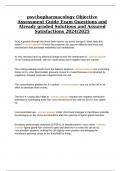psychopharmacology Objective
Assessment Guide Exam Questions and
Already graded Solutions and Assured
Satisfactions 2024/2025
Drug X passes through the blood-brain barrier via active transport. What does this
mean? - correct answer It lacks the properties for passive diffusion and must use
mechanisms that penetrate endothelial cell membranes
At rest, neurons have an electrical charge across the membrane of - correct answer -
70 mV (resting potential), with the inside being more negative than the outside
The resting potential results from the balance between - correct answer two competing
forces on K+ ions. Electrostatic pressure moves K+ inward because it is attracted by
negatively charged molecules trapped inside the cell.
The concentration gradient for K+ pushes - correct answer ions out of the cell in an
effort to distribute them evenly.
The Na+-K+ pump also helps to - correct answer maintain the negative membrane
potential by exchanging three Na+ ions (moved out of the cell) for two K+ ions (taken
in).
Local potentials are - correct answer small, short-lived changes in membrane potential
found largely on the soma and dendrites after the opening of ligand-gated channels.
Excitatory postsynaptic potentials (EPSPs), or depolarizations, occur when - correct
answer ligand-gated Na+ channels open and allow Na+ to enter the cell on its
concentration gradient, making the cell slightly more positive and bringing the
membrane potential closer to the threshold for firing.
,Excitatory postsynaptic potentials (EPSPs) are depolarization - correct answer
depolarizations
Opening Cl- channels allows Cl- to enter on its concentration gradient, making the cell
more negative and farther from the threshold, causing - correct answer
hyperpolarizations called inhibitory postsynaptic potentials (IPSPs).
When ligand-gated K+ channels open, K+ - correct answer exits on its concentration
gradient, leaving the cell more negative inside and farther from the threshold producing
an IPSP.
The summation of all EPSPs and IPSPs occurring at any single moment in time occurs
at the - correct answer axon hillock
If the threshold (-50 mV) is reached, voltage-gated Na+ channels open, allowing large
amounts of - correct answer Na+ to enter the cell to produce the massive
depolarization known as the action potential.
At the peak of the action potential (+40 mV), voltage-gated Na+ channels close and
cannot be opened until - correct answer they reset at the resting potential, so no action
potential can occur during this time (the absolute refractory period).
As the cell becomes more positive inside, voltage-gated K+ channels open and -
correct answer K+ exits from the cell, bringing the membrane potential back toward
resting levels.
The overshoot by K+ causes the cell to be more polarized than normal, so it is more
difficult to - correct answer reach the threshold to generate another action potential
(relative refractory period).
The action potential moves down the length of the axon by - correct answer sequential
opening of voltage-gated Na+ channels.
,In myelinated axons, regeneration of the action potential occurs only at the nodes of
Ranvier, producing a - correct answer rapid, saltatory conduction that is more energy
efficient because the Na+-K+ pump needs to exchange ions only at the nodes.
The central nervous system (CNS) includes - correct answer the brain and the spinal
cord. The remaining nerves of the body constitute the peripheral nervous system (PNS).
The PNS is divided into the somatic nervous system, which includes - correct answer
spinal nerves that transmit sensory and motor information for skeletal muscles, and the
autonomic nervous system, which serves smooth muscles, glands, and visceral organ
The autonomic nervous system has two divisions: - correct answer the sympathetic,
which serves to mobilize energy for times of "fight-or-flight"; and the parasympathetic,
which reduces energy usage and stores reserves.
The CNS is protected by - correct answer a bony covering, three layers of meninges
(dura, arachnoid, and pia), and cerebrospinal fluid.
Neurotrophic factors are neuronal growth factors that guide the - correct answer
development of neurons, regulate dendritic growth and retraction, and aid in survival of
neurons.
The CNS can be divided into six regions containing multiple nuclei and their associated
axons, which form - correct answer interconnecting neural circuits: spinal cord,
myelencephalon, metencephalon, mesencephalon, diencephalon, and telencephalon.
The gray matter of the spinal cord constitutes - correct answer cell bodies that receive
sensory information and cell bodies of motor neurons that serve muscles.
The white matter consists of tracts of - correct answer myelinated axons that carry
signals in the ascending direction, to the brain, and the descending direction, for cortical
control of the spinal cord.
, Continuous with the spinal cord is the - correct answer myelencephalon, or medulla,
which contains nuclei that serve vital functions for survival, such as respiration, heart
rate, and vomiting.
mitochondria make - correct answer atp
Beginning in the medulla, running through the pons, and extending into the midbrain is
the - correct answer reticular formation—a network of interconnected nuclei that
control arousal, attention, and survival functions
The mesencephalon, or midbrain, contains nuclei that control - correct answer sensory
reflexes such as pupillary constriction. Other nuclei (substantia nigra and ventral
tegmental area) are the cell bodies of neurons that form three major dopaminergic
tracts.
The periaqueductal gray organizes behaviors such as - correct answer defensive rage
and predation and serves as an important pain-modulating center.
The diencephalon contains the - correct answer thalamus, which relays information to
the cerebral cortex, and the hypothalamus, which is important for maintaining
homeostasis of physiological functions and for modulating motivated behaviors,
including eating, aggression, reproduction, and so forth.
The many nuclei that constitute the hypothalamus control both - correct answer the
autonomic nervous system and the endocrine system.
The telencephalon includes both the - correct answer cerebral cortex and multiple
subcortical structures, including the basal ganglia and the limbic system.
The limbic system is made up of several brain structures with perfuse interconnections
that modulate - correct answer emotion, motivation, and learning
he basal ganglia modulate . - correct answer movement




